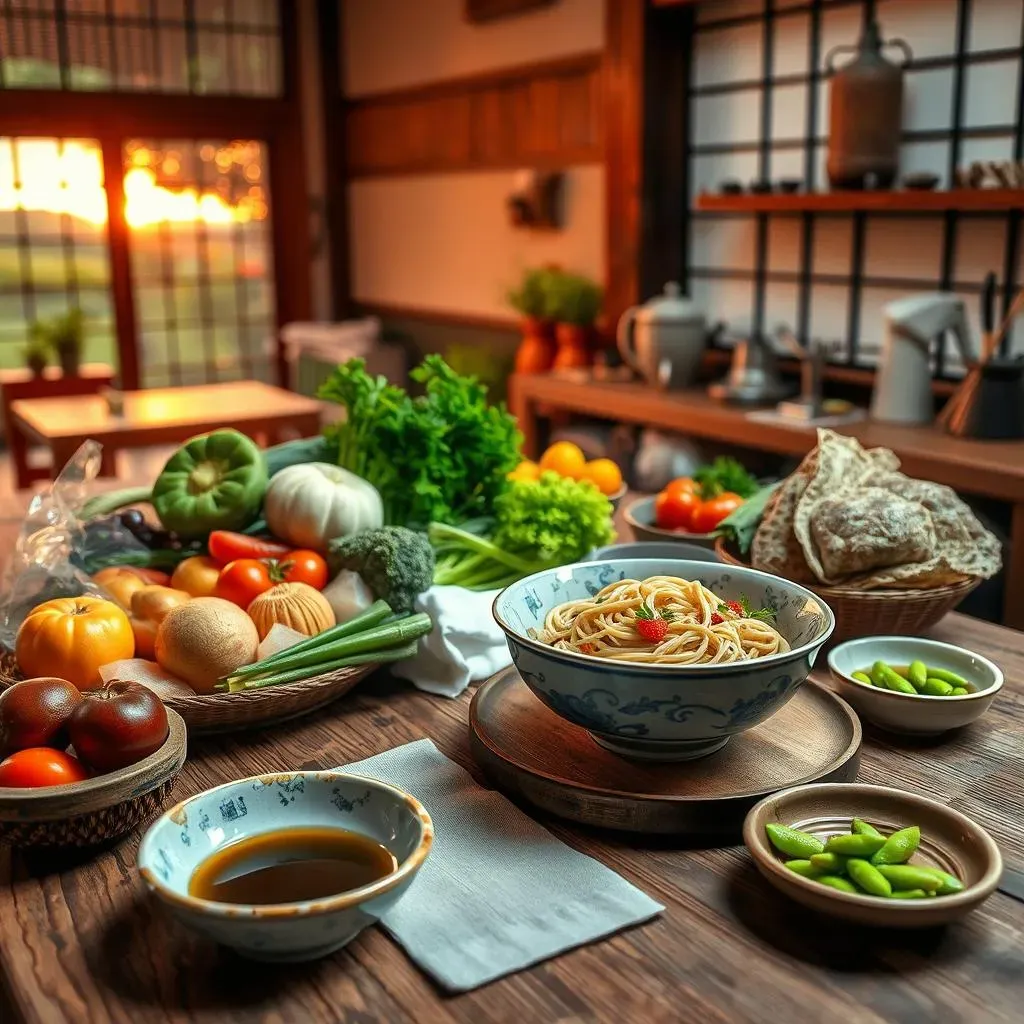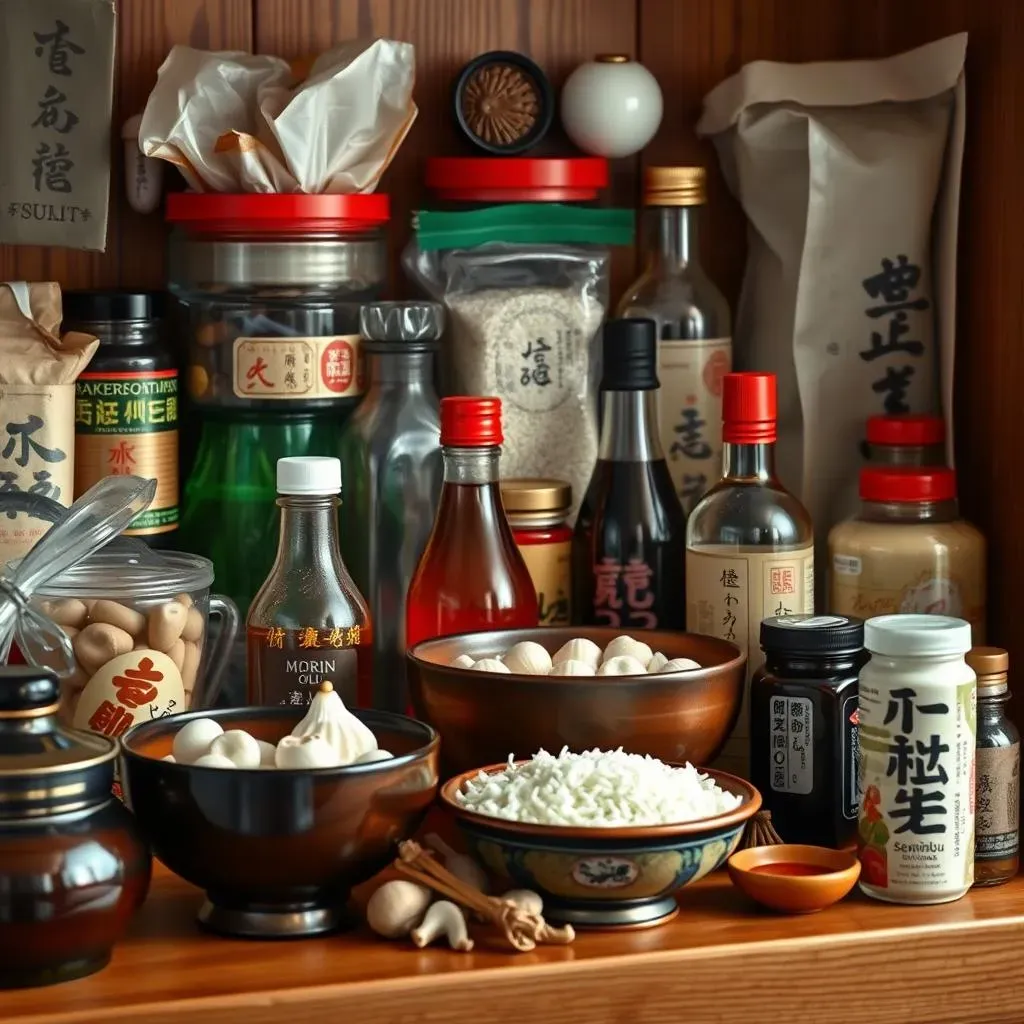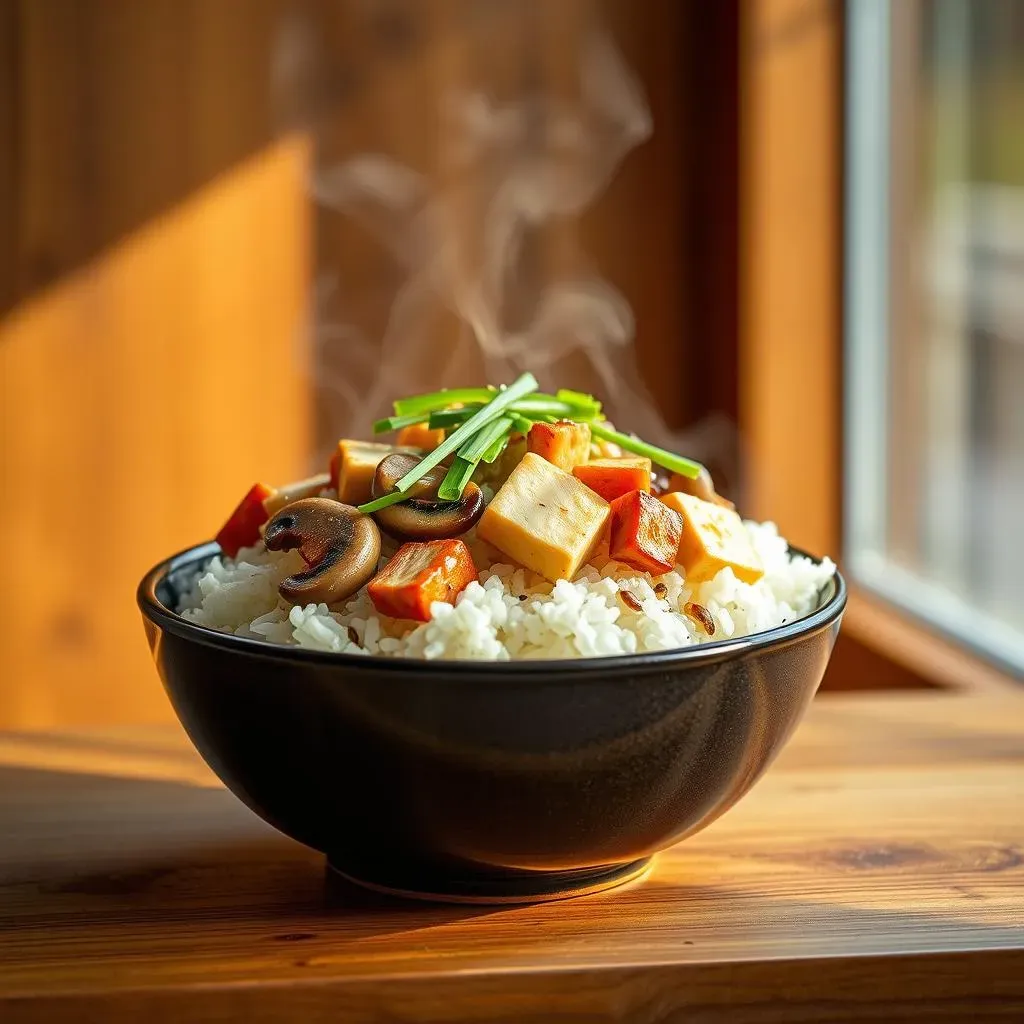Table of Contents
Ever wondered if you could enjoy the amazing flavors of Japan without the fish and meat? You're not alone! Many people are curious about the vegetarian Japanese diet, and it’s totally possible to experience this unique cuisine in a plant-based way. We're going to explore how to make the transition, making it both delicious and doable. This isn't about bland tofu and sad salads, but rather a journey into vibrant flavors, exciting textures, and meals that are both nourishing and satisfying. We’ll cover the basics of building a balanced vegetarian Japanese diet, from knowing what ingredients to stock in your pantry to some tasty recipes you can try at home. We'll also take a look at the fascinating world of Shojin Ryori, the traditional vegetarian cuisine of Buddhist temples. Whether you're a seasoned vegetarian or just curious, this guide will help you navigate the world of vegetarian Japanese diet with confidence and a full belly!
Building a Balanced Vegetarian Japanese Diet
Building a Balanced Vegetarian Japanese Diet
so you're diving into the world of vegetarian Japanese food? Awesome! It’s not just about swapping out meat for tofu, it's about understanding how Japanese cuisine works to create balanced and delicious meals. Think of it like building a house; you need a solid foundation. In this case, that foundation is a good balance of carbs, proteins, and healthy fats. Japanese meals often include a staple carbohydrate like rice or noodles, plenty of veggies (think colorful and seasonal), and a good source of plant-based protein like tofu, edamame, or natto. Don't forget the importance of healthy fats from sources like sesame oil or avocado. It's all about variety and making sure you're getting all the nutrients your body needs.
It's also worth noting that Japanese cuisine uses a lot of umami, that savory flavor that makes food taste so good. Instead of relying on meat for that, we can use ingredients like mushrooms, soy sauce, and kombu (seaweed) to create that depth of flavor. It's like adding an extra layer of awesome to your meal. When you're planning your meals, try to think about incorporating different textures too: something crunchy, something soft, something chewy. The balance of textures, flavors, and nutrients is what makes a truly satisfying Japanese meal. It's a fun puzzle to solve, and the result is always worth it!
Nutrient | Japanese Vegetarian Sources |
|---|---|
Carbohydrates | Rice, Noodles (Udon, Soba), Sweet Potato |
Proteins | Tofu, Edamame, Natto, Tempeh |
Healthy Fats | Avocado, Sesame Oil, Nuts |
Umami | Mushrooms, Soy Sauce, Kombu, Shiitake |
Essential Pantry Items for Vegetarian Japanese Cooking
Essential Pantry Items for Vegetarian Japanese Cooking
The Must-Haves
so you're ready to cook up some amazing vegetarian Japanese dishes? First things first, let's talk pantry essentials. Think of these as your trusty sidekicks in the kitchen. You absolutely need soy sauce; it’s the backbone of so many Japanese flavors. It's not just for dipping sushi, it's the soul of Japanese cooking! Next up, rice. White rice is the classic choice, but brown rice works great too if you’re looking for more fiber. And of course, you can’t forget about mirin, a sweet rice wine that adds a touch of sweetness and depth.
These three are like the holy trinity of Japanese cooking. These ingredients are what give Japanese food it’s distinct taste profile. I always make sure I have a few bottles of soy sauce. It's that crucial! Mirin adds this subtle sweetness which is just irreplaceable.
Flavor Boosters and Other Essentials
Now that we’ve covered the basics, let's add some flavor boosters. Kombu (dried kelp) and dried shiitake mushrooms are essential for making dashi, a flavorful broth that’s used in many Japanese dishes. They bring a deep, earthy umami flavor that you just can't get anywhere else. Then, there’s sesame oil, which adds a nutty aroma and flavor to stir-fries and dressings. Don't forget about rice vinegar, it's great for adding a little tang to your dishes and for making sushi rice.
These items will elevate your cooking so much. The dashi alone will transform your miso soups and noodle dishes. I always have a jar of dried shiitake mushrooms on hand, it's perfect for a quick broth. I like to use sesame oil in almost everything!
Pantry Item | Why You Need It |
|---|---|
Soy Sauce | Essential for flavor, saltiness, and umami |
Rice | Staple carbohydrate, pairs with everything |
Mirin | Adds sweetness and depth of flavor |
Kombu & Shiitake | For making dashi, adds umami |
Sesame Oil | Adds nutty aroma and flavor |
Rice Vinegar | Adds tang and perfect for sushi rice |
The Extras That Make a Difference
Finally, let's talk about some extras that can really take your Japanese vegetarian cooking to the next level. Things like miso paste (for miso soup, duh!), nori seaweed (for sushi and other dishes), and different types of noodles like udon and soba. These aren’t absolutely crucial for every single dish, but having them around allows you to experiment and explore different recipes. And don’t forget about things like sesame seeds, both black and white, for a little extra texture and flavor. With these items, your pantry will be more than ready to create amazing Japanese vegetarian dishes!
Trust me, having a well stocked pantry makes all the difference. It's like having a secret weapon in the kitchen. I can whip up a quick miso soup or a stir fry in no time. And it's always fun to try new recipes when you have all the ingredients on hand.
Delicious and Simple Vegetarian Japanese Recipes
Delicious and Simple Vegetarian Japanese Recipes
Quick and Easy Tofu Donburi
Alright, let's get cooking! If you're looking for a super quick and satisfying meal, Tofu Donburi is where it's at. It’s basically a Japanese rice bowl, and it's so simple to throw together. You just need some firm tofu, soy sauce, mirin, a bit of sugar, and some veggies like onions and mushrooms. You’ll cook the tofu and veggies in the sauce, then just slide it over a bowl of hot rice. It’s comforting, flavorful, and ready in like 20 minutes. I mean, who doesn't love a good rice bowl? It's my go-to for a weeknight meal when I'm short on time.
The best part? You can totally customize it! Throw in whatever veggies you have on hand, like spinach, carrots, or even some broccoli. The key is to get that sauce just right, it's the perfect blend of salty, sweet, and savory. It's like a little hug in a bowl, I swear. I've even added a little ginger to mine for an extra kick, it's a game changer. Don't be afraid to experiment and make it your own.
Miso Soup Magic
Next up is Miso Soup. This isn't your average soup, it's a staple in Japanese cuisine and it's packed with flavor and nutrients. It’s also incredibly easy to make. You'll need some dashi (that broth we talked about earlier), miso paste, and some tofu and seaweed. You whisk the miso into the dashi, add your tofu and seaweed, and boom, you have a warm and comforting bowl of soup. It's seriously that simple. I always start my day with a bowl of miso soup, it’s like a little warm hug for my stomach.
The beauty of miso soup is its simplicity. You can add different veggies, like green onions or mushrooms, to make it your own. And there are different types of miso paste you can use, each with its own unique flavor. It’s a great way to get your daily dose of probiotics and it’s perfect for a light lunch or a side dish with your dinner. It’s the most versatile soup out there, I think. It's also a great way to use up any leftover veggies you might have.
Recipe | Main Ingredients | Why It's Awesome |
|---|---|---|
Tofu Donburi | Tofu, Soy Sauce, Mirin, Rice | Quick, Customizable, Satisfying |
Miso Soup | Dashi, Miso Paste, Tofu, Seaweed | Simple, Nutritious, Versatile |
Simple Veggie Sushi Rolls
who doesn't love sushi? I know, it might sound intimidating, but making veggie sushi rolls at home is actually pretty fun and easy. You’ll need some sushi rice, nori seaweed sheets, and your favorite veggies like cucumber, avocado, and carrots. Just spread the rice on the nori, add your veggies, and roll it all up tightly. It's like making a little edible art project. And it tastes just as good as it looks! I love having sushi night with friends, it’s a fun way to get everyone involved in the kitchen.
Don't worry if your first few rolls aren't perfect, it takes a little practice. The key is to use a sharp knife and to wet your hands a bit so the rice doesn't stick. And get creative with your fillings! Try adding some pickled ginger or some marinated tofu for extra flavor. It's all about experimenting and having fun with it. I've even tried adding some mango to mine, it’s surprisingly delicious. Just remember to have fun and enjoy the process. It's a great way to impress your friends and family with your amazing culinary skills.
Exploring Shojin Ryori: The Art of Vegetarian Japanese Temple Food
Exploring Shojin Ryori: The Art of Vegetarian Japanese Temple Food
The Philosophy Behind Shojin Ryori
so you've heard of vegetarian Japanese food, but have you ever heard of Shojin Ryori? It's like the OG vegetarian Japanese cuisine, and it's way more than just a diet, it's a philosophy. Shojin Ryori is the traditional Buddhist temple cuisine, and it's all about mindfulness and respect for ingredients. It's not just about what you eat, but how you prepare and consume food. The goal is to nourish both the body and the spirit, and it’s a practice of gratitude. It's like a form of meditation, but with food and I find it fascinating.
The key principles of Shojin Ryori are avoiding the use of animal products, minimizing waste, and using seasonal ingredients. They believe that all living things have a life force, and they aim to honor that in their cooking. It's all about simplicity and allowing the natural flavors of the ingredients to shine through. It's a beautiful expression of respect for nature and it's a very different way of thinking about food compared to modern cooking. It is a refreshing approach and I'm really starting to appreciate it.
Key Elements of Shojin Ryori
So, what does Shojin Ryori actually look like on a plate? Well, you won't find any extravagant dishes, it's all about simple, wholesome food. Think of it as a celebration of vegetables, tofu, and other plant-based ingredients. One of the main elements is using a variety of cooking methods to bring out different flavors and textures. You’ll see things like steaming, simmering, and pickling. They also use a lot of umami-rich ingredients like kombu and shiitake mushrooms to add depth to the dishes. It's all about making the most of what you have and creating a balanced meal.
Another important thing is the concept of "mottainai," which means avoiding waste. They use every part of the ingredient as much as possible. For example, they might use the stems of vegetables to make a broth, or they might pickle the peels. It's a very sustainable and resourceful approach to cooking. And the presentation is also important, they aim for a beautiful and harmonious arrangement of dishes on the table. It's like a work of art, it's meant to be pleasing to the eyes as well as the palate. I think it's a fantastic way to honor food.
Principle | Description |
|---|---|
No Animal Products | Excludes all meat, fish, and animal by-products |
Seasonal Ingredients | Uses fresh, seasonal vegetables and fruits |
Minimal Waste | Utilizes all parts of ingredients to minimize waste |
Mindful Preparation | Focuses on simplicity and respect for the ingredients |
Balanced Flavors | Creates harmonious dishes with a variety of flavors and textures |
Wrapping Up Your Vegetarian Japanese Diet Journey
Embarking on a vegetarian Japanese diet is an exciting adventure, not a restrictive chore. It’s about discovering new flavors, appreciating simple ingredients, and finding joy in mindful cooking. From stocking your pantry with the essentials to mastering a few key recipes, you’ve got the tools to create delicious and balanced meals. And don't forget the rich history and traditions of Shojin Ryori, which offer a unique perspective on plant-based eating. So, go ahead, experiment, taste, and most importantly, enjoy the wonderful world of the vegetarian Japanese diet! There's always something new to learn and taste, so keep exploring, and happy cooking!